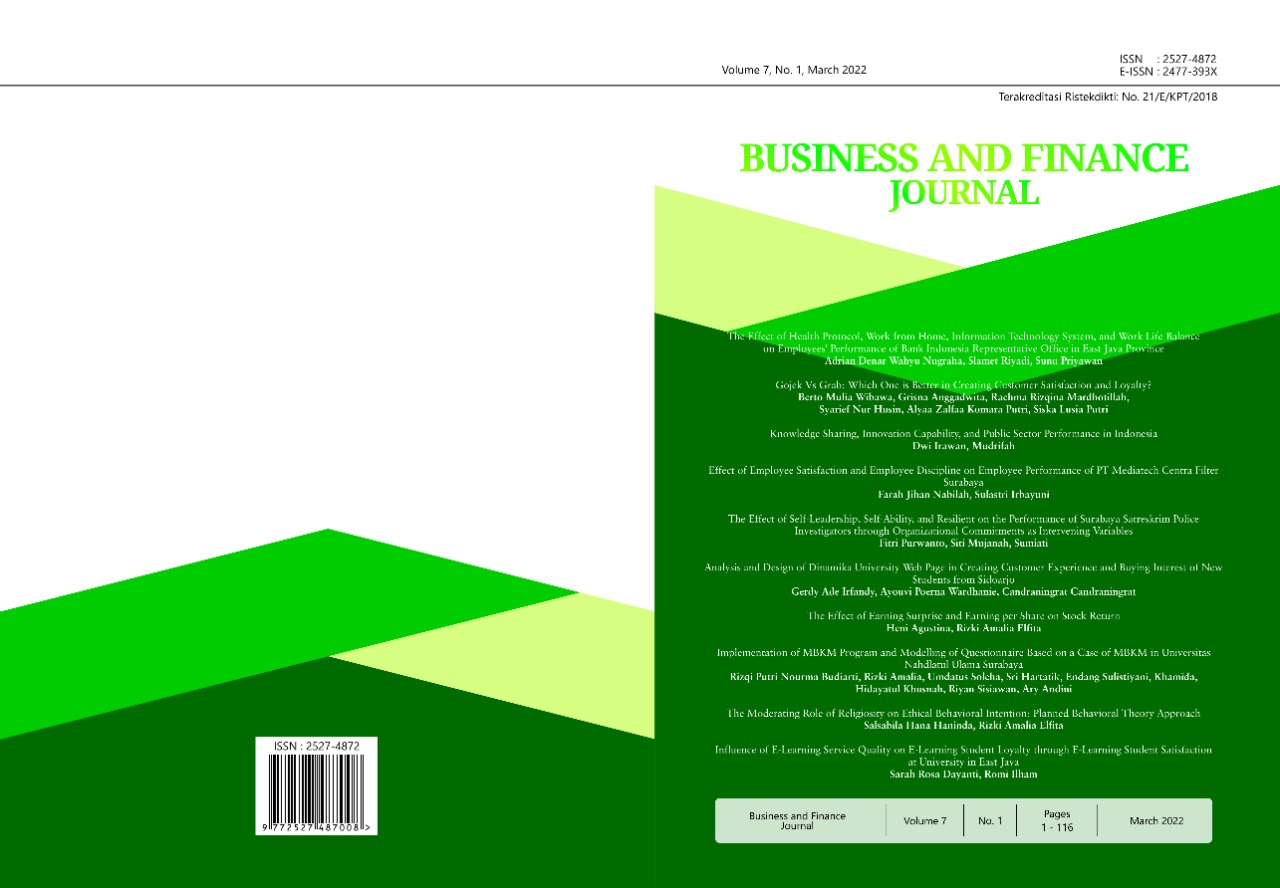Gojek VS Grab: Which One Is Better in Creating Customer Satisfaction and Loyalty?
##plugins.themes.bootstrap3.article.main##
Abstract
Online ride-hailing is now becoming a popular option for customers to travel worldwide, including for consumers in Indonesia. However, the Covid-19 pandemic caused many force majeure problems for companies serving online ride-hailing services. These situations lead to numerous customer dissatisfaction, low switching cost, and disloyalty for customers to use online ride-hailing services. In particular, this study aims to investigate the comparison of customer satisfaction and loyalty level between Gojek and Grab. This study used the online-survey method with a total sample of 569 usable online responses. The data analysis was carried out by calculating the importance-performance analysis, customer satisfaction index, and customer loyalty index. Our findings illustrate that the competition between two companies is very tight and competitive. Based on service satisfaction, Gojek is slightly better than Grab. Nevertheless, in terms of loyalty, the level of loyalty of Grab consumers is more loyal than Gojek consumers. Hence, instead of competing head to head, it would be more effective for Gojek and Grab to have diverse service strategies to provide more varied benefits to society.
Downloads
##plugins.themes.bootstrap3.article.details##
Copyright (c) 2022 Berto Mulia Wibawa, Grisna Anggadwita, Rachma Rizqina Mardhotillah, Syarief Nur Husin, Alyaa Zalfaa Komara Putri, Siska Lusia Putri

This work is licensed under a Creative Commons Attribution-ShareAlike 4.0 International License.
References
Aydin, S., & Özer, G. (2005). National Customer Satisfaction Indices: an implementation in the Turkish mobile telephone market. Marketing Intelligence & Planning, 23(5), 486-504.
Bilgihan, A. (2016). Gen Y customer loyalty in online shopping: An integrated model of trust, user experience and branding. Computers in Human Behavior, 61(8), 103-113.
Bukhari, E., & Ramadhan, A. (2020). Analisis komparasi penghasilan driver Gojek dan grab terhadap standar upah minimum regional kota bekasi pada saat pandemi Covid-19. Jurnal Ilmiah Akuntansi Dan Manajemen, 16(2), 26–31.
Cohen, B., & Kietzmann, J. (2014). Ride on! Mobility business models for the sharing economy. Organization & Environment, 27(3), 279-296.
Ennew, C. T., Reed, G. V., & Binks, M. R. (1993). Importance-performance analysis and the measurement of service quality. European Journal of Marketing, 27(2), 59-70.
Feeney, M. (2015). Is ridesharing safe?. Cato Institute Policy Analysis, (767).
Fornell, C. (1992). A national customer satisfaction barometer: The Swedish experience. Journal of Marketing, 52(1), 6-21.
Griffin, J., & Herres, R. T. (2002). Customer loyalty: How to earn it, how to keep it (p. 18). San Francisco, CA: Jossey-Bass.
Hamari, J., Sjöklint, M., & Ukkonen, A. (2016). The sharing economy: Why people participate in collaborative consumption. Journal of the Association for Information Science and Technology, 67(9), 2047-2059.
Irawati, D. Y., & Ezrani, O. (2018). Servqual dan conjoint analysis dalam house of quality untuk layanan ojek online. Jurnal Teknik Industri, 19(1), 84-98.
Karya, D. F. (2016). Analisis Kualitas Layanan dan Kepuasan Pengunjung Perpustakaan Kampus A Universitas Nahdlatul Ulama Surabaya (Unusa). Business and Finance Journal 1 (2).
Karya, D. F. (2020). Customer Loyalty Perspective Developed From Customer Commitment. Journal Of Applied Management and Business (JAMB) 1 (1), 20-26.
Kotler, P., & Keller, K. L. (2016). A framework for marketing management. Boston, MA: Pearson.
Lefever, S., Dal, M., & Matthiasdottir, A. (2007). Online data collection in academic research: advantages and limitations. British Journal of Educational Technology, 38(4), 574-582.
Malhotra, N., Nunan, D., & Birks, D. (2017). Marketing research: An applied approach. Pearson.
Martilla, J. A., & James, J. C. (1977). Importance-performance analysis. The Journal of Marketing, 41(1), 77-79.
Nadiri, H., & Hussain, K. (2005). Diagnosing the zone of tolerance for hotel services. Managing Service Quality: An International Journal. 15(3), 259-277.
Oliver, R. L. (1980). A cognitive model of the antecedents and consequences of satisfaction decisions. Journal of Marketing Research, 17(4), 460-469.
Oliver, R. L. (1999). Whence consumer loyalty?. Journal of Marketing, 63(1): 33-44.
Parasuraman, A., Zeithaml, V. A., & Berry, L. L. (1985). A conceptual model of service quality and its implications for future research. The Journal of Marketing, 49(4), 41-50.
Parasuraman, A., Zeithaml, V. A., & Berry, L. L. (1988). Servqual: A multiple-item scale for measuring consumer perceptions of service quality. Journal of Retailing, 64(1), 12-40.
Patterson, P. G., & Spreng, R. A. (1997). Modelling the relationship between perceived value, satisfaction and repurchase intentions in a business-to-business, services context: an empirical examination. International Journal of service Industry management, 8(5), 414-434.
Piero, M., Wibawa, B. M., & Persada, S. F. (2018). Identifikasi Perilaku Compulsive Buying pada Mahasiswa di Surabaya. Jurnal Sains dan Seni ITS, 7(1), 15-17.
Pratama, M. G., Wibawa, B. M., & Kunaifi, A. (2017). Analisis Deskriptif Konsumen Dan Mitra Pengemudi Pada Jasa Transportasi Online Ride Sharing. Jurnal Sains dan Seni ITS: 6(2), D164-D167.
Rainaldo, M., Wibawa, B. M., & Rahmawati, Y. (2017). Analisis Business Model Canvas Pada Operator Jasa Online Ride-Sharing (Studi Kasus Uber di Indonesia). Jurnal Sains dan Seni ITS, 6(2), D232-D236.
Tse, D. K., & Wilton, P. C. (1988). Models of consumer satisfaction formation: An extension. Journal of Marketing Research, 25(2), 204-212.
Wibawa, B. M., & Aryanto, M. F. (2016). Optimalisasi strategi pemasaran lembaga bimbingan belajar Bahasa Inggris menggunakan metode education service quality. Jurnal Manajemen, 13(1), 21-57.
Wibawa, B. M., Rahmawati, Y., & Rainaldo, M. (2018). Analisis Industri Bisnis Jasa Online Ride Sharing di Indonesia. Jurnal Bisnis dan Manajemen, 8(1), 9-20.
Yang, Z., & Peterson, R. T. (2004). Customer perceived value, satisfaction, and loyalty: The role of switching costs. Psychology & Marketing, 21(10), 799-822.
Yayasan Lembaga Konsumen Indonesia. (2017). Transportasi Online; Kawan atau Lawan?. Retrieved 28 Februari 2018; https://ylki.or.id/2017/07/warta-konsumen-transportasi-online-kawan-atau-lawan/.
Yen, C. H., & Lu, H. P. (2008). Effects of e-service quality on loyalty intention: an empirical study in online auction. Managing Service Quality: An International Journal, 18(2), 127-146.

